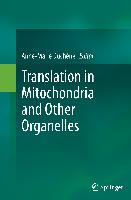- Start
- Translation in Mitochondria and Other Organelles
Translation in Mitochondria and Other Organelles
Angebote / Angebote:
The present book gives an overview on the similarities and differences of the various translation systems. Moreover, it highlights the mechanisms and control of translation in mitochondria and other organelles such as plastids and apicoplasts in different organisms. Lastly, it offers an outlook on future developments and applications that might be made possible by a better understanding of translation in mitochondria and other organelles. Mitochondria and plastids originate from the endosymbiosis of bacteria. Over the course of evolution, most of the bacterial genes have been lost or transferred to the nuclear genome. Present-day mitochondria and plastids retain only a vestige of the genome of the ancestral bacteria, but the few organellar-encoded protein genes remain essential and must be translated.Organellar translation machineries present clear specificities compared to cytosolic translation machineries, but also from one organism to the other. The organellar translation machineries appear to consist of organellar-encoded and nucleus-encoded components. They rely on crosstalk between genomes and are predominantly controlled by specific mechanisms. Organellar ribosomes show clear differences compared to the ancestral bacterial ribosomes or to the cytosolic ones. Moreover, transfer RNAs and aminoacyl-tRNA synthetases are key components of protein-synthesizing systems, and a full set of both types of macromolecules is required in each compartment where translation occurs.Organellar translations are increasingly becoming a subject of investigation. Translation dysfunctions in human mitochondria are responsible for numerous diseases, and organellar translation systems in some parasites offer potential targets for drug development. Lastly, chloroplasts can be used as platforms for the production of recombinant proteins.
Lieferbar in ca. 20-45 Arbeitstagen
